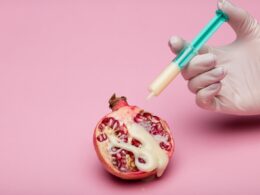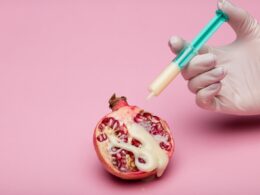Men produce millions of sperm cells each day, but they don’t mature into fertile sperm until a man gets sexually aroused. At that point, sperm move from their storage vessel in the testicles to a tube called the epididymis where they mix with fluids from the prostate gland and seminal vesicles.
How does it happen?
A man’s body produces millions of sperm cells each day. It takes them about 2.5 months to become mature sperm that can fertilize an egg. This process is known as spermatogenesis.
During this process, a man’s pituitary gland produces the hormones luteinizing hormone (LH) and follicle-stimulating hormone (FSH). These hormones travel to the testicles through the bloodstream. The FSH and LH stimulate the Leydig cells in the testicles to produce testosterone, which helps sperm develop. The immature sperm cells, called spermatogonia, are located in the thin, tightly coiled tubules that make up the outer walls of the testes. These cells are surrounded by the Sertoli cells, which support and nourish them. During spermatogenesis, the sperm cells multiply and undergo several changes, including removing their nucleus. In addition, histones in the sperm cell nucleus are replaced with proteins that are over 60% arginine. This makes the sperm cell less acidic and enables it to bind with the female egg more easily.
The sperm cells then enter the ducts behind the testicles called the epididymis. They continue to grow and transform until they take on the tadpole shape we associate with sperm, complete with tails. In order for sperm to fertilize an egg, they need to reach it within the fertile window that occurs in a woman’s menstrual cycle. Once ejaculated, a man’s sperm can survive for only a few minutes outside the body, where it will break down and be reabsorbed.
How long does it take for sperm to mature?
The human body is constantly producing sperm cells in a process called spermatogenesis. As long as hormones are present, these diploid sperm cells (spermatocytes) divide and grow until they’re almost mature, and then they enter the seminiferous tubules of the testicles where they’re converted to sperm (spermatids). Your testicles produce several million sperm every day. A full sperm production cycle takes about 64 days.
Mature sperm are structurally complete and have three parts: a head that carries genetic material; a midpiece that produces energy to enable swimming once they’re released into seminal fluid; and a tail that propels sperm through the female reproductive tract for fertilization. Once they’ve reached the epididymis, a tube connected to your testicles that preserves sperm until it’s time for them to be ejected, they gain motility—the ability to move—which is necessary for sperm to survive after being released in a woman’s seminal fluid, or semen.
Sperm live for about 5 days after ejaculation, but their lives can be significantly shorter than that depending on the environmental conditions they’re in. For this reason, it’s important for men to make dietary and lifestyle changes well before trying to conceive, so they can maximize the number of viable sperm they have to fertilize an egg. That’s why a test of your semen is such a crucial first step before starting a family.
What is sperm?
Sperm are tiny cells that move through the body’s reproductive tract in hopes of fertilizing a woman’s egg. They’re only about 0.025 inch long (a little longer than a human hair). Sperm cells (called spermatozoa) have two basic parts, the head and the tail. The head is oblong or oval and contains 23 chromosomes, which will be passed on to the female egg. The sperm’s tail is much longer and has mitochondria that generate energy to help propel the sperm.
The sperm production process, known as spermatogenesis, starts in vessels called seminiferous tubules in the testes. Cells there become germ cells by undergoing a type of cell division that produces multiple haploid spermatids. These immature sperm cells contain half the genetic variation of a normal, complete cell. The haploid spermatids are then fertilized with an egg from the woman’s body to produce a zygote, or diploid cell with full genetic material.
As sperm mature, they move into the vas deferens, a tube that runs from the testis to the prostate gland in the penis. The prostate gland contributes fluid that mixes with the sperm to form semen. Sexual stimulation launches the next step in sperm’s journey, which is toward the female reproductive tract. During the process, semen is released into the seminal vesicles, then into the urethra and penis.
What are the stages of sperm production?
There are many factors that can affect sperm count, quality and motility, including age, health and lifestyle. In general, a man’s sperm cells live longer inside the body (up to 72 hours) than outside of it (around 24 hours).
Millions of sperm are produced in a system of tubes in the testicles called the seminiferous tubules each day. These germ cells are transformed by hormones, especially testosterone, into sperm with a genetic head and tail that will swim to an egg cell and fertilize it. This process is known as spermiogenesis or more technically, spermatogenesis.
The first stage of sperm production is spermatocytogenesis, when diploid primordial germ cells called spermatogonia divide to form spermatocytes. These then undergo meiosis to produce haploid spermatids. As they transform into mature sperm cells, the spermatids have a tadpole shape with a tail and a head that contains an acrosome to release enzymes that help the sperm fertilize an egg.
Once sperm are fully mature, they move into the epididymis, a tube behind the testes that preserves them until they are needed. Then, sexual stimulation triggers a complex series of events that allows sperm to mix with a fluid from the prostate gland and seminal vesicles into a thick white substance called semen. This mixture is then ejaculated from the penis and through the urethra.





